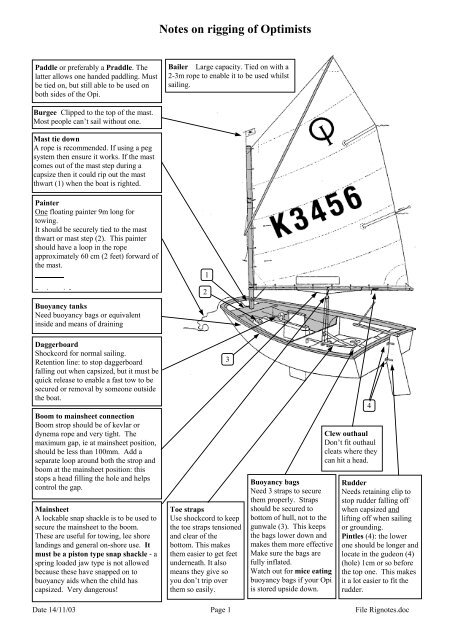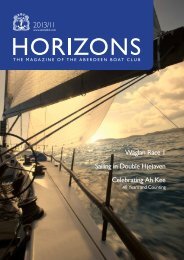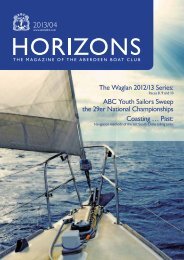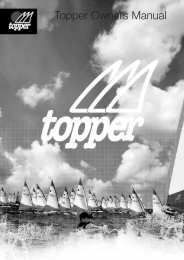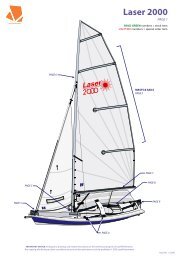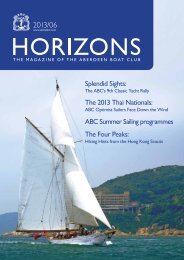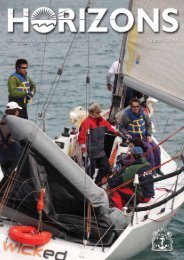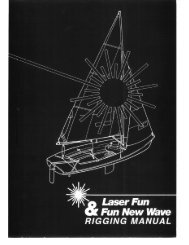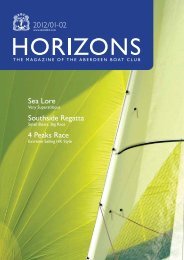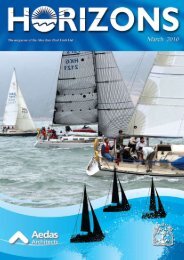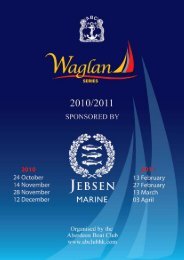Notes on rigging of Optimists - the Aberdeen Boat Club
Notes on rigging of Optimists - the Aberdeen Boat Club
Notes on rigging of Optimists - the Aberdeen Boat Club
You also want an ePaper? Increase the reach of your titles
YUMPU automatically turns print PDFs into web optimized ePapers that Google loves.
Paddle or preferably a Praddle. The<br />
latter allows <strong>on</strong>e handed paddling. Must<br />
be tied <strong>on</strong>, but still able to be used <strong>on</strong><br />
both sides <strong>of</strong> <strong>the</strong> Opi.<br />
Burgee Clipped to <strong>the</strong> top <strong>of</strong> <strong>the</strong> mast.<br />
Most people can’t sail without <strong>on</strong>e.<br />
Mast tie down<br />
A rope is recommended. If using a peg<br />
system <strong>the</strong>n ensure it works. If <strong>the</strong> mast<br />
comes out <strong>of</strong> <strong>the</strong> mast step during a<br />
capsize <strong>the</strong>n it could rip out <strong>the</strong> mast<br />
thwart (1) when <strong>the</strong> boat is righted.<br />
Painter<br />
One floating painter 9m l<strong>on</strong>g for<br />
towing.<br />
It should be securely tied to <strong>the</strong> mast<br />
thwart or mast step (2). This painter<br />
should have a loop in <strong>the</strong> rope<br />
approximately 60 cm (2 feet) forward <strong>of</strong><br />
<strong>the</strong> mast.<br />
9 i j k<br />
Buoyancy tanks<br />
Need buoyancy bags or equivalent<br />
inside and means <strong>of</strong> draining<br />
Daggerboard<br />
Shockcord for normal sailing.<br />
Retenti<strong>on</strong> line: to stop daggerboard<br />
falling out when capsized, but it must be<br />
quick release to enable a fast tow to be<br />
secured or removal by some<strong>on</strong>e outside<br />
<strong>the</strong> boat.<br />
Boom to mainsheet c<strong>on</strong>necti<strong>on</strong><br />
Boom strop should be <strong>of</strong> kevlar or<br />
dynema rope and very tight. The<br />
maximum gap, ie at mainsheet positi<strong>on</strong>,<br />
should be less than 100mm. Add a<br />
separate loop around both <strong>the</strong> strop and<br />
boom at <strong>the</strong> mainsheet positi<strong>on</strong>: this<br />
stops a head filling <strong>the</strong> hole and helps<br />
c<strong>on</strong>trol <strong>the</strong> gap.<br />
Mainsheet<br />
A lockable snap shackle is to be used to<br />
secure <strong>the</strong> mainsheet to <strong>the</strong> boom.<br />
These are useful for towing, lee shore<br />
landings and general <strong>on</strong>-shore use. It<br />
must be a pist<strong>on</strong> type snap shackle - a<br />
spring loaded jaw type is not allowed<br />
because <strong>the</strong>se have snapped <strong>on</strong> to<br />
buoyancy aids when <strong>the</strong> child has<br />
capsized. Very dangerous!<br />
<str<strong>on</strong>g>Notes</str<strong>on</strong>g> <strong>on</strong> <strong>rigging</strong> <strong>of</strong> <strong>Optimists</strong><br />
Bailer Large capacity. Tied <strong>on</strong> with a<br />
2-3m rope to enable it to be used whilst<br />
sailing.<br />
1<br />
2<br />
3<br />
Toe straps<br />
Use shockcord to keep<br />
<strong>the</strong> toe straps tensi<strong>on</strong>ed<br />
and clear <strong>of</strong> <strong>the</strong><br />
bottom. This makes<br />
<strong>the</strong>m easier to get feet<br />
underneath. It also<br />
means <strong>the</strong>y give so<br />
you d<strong>on</strong>’t trip over<br />
<strong>the</strong>m so easily.<br />
Buoyancy bags<br />
Need 3 straps to secure<br />
<strong>the</strong>m properly. Straps<br />
should be secured to<br />
bottom <strong>of</strong> hull, not to <strong>the</strong><br />
gunwale (3). This keeps<br />
<strong>the</strong> bags lower down and<br />
makes <strong>the</strong>m more effective<br />
Make sure <strong>the</strong> bags are<br />
fully inflated.<br />
Watch out for mice eating<br />
buoyancy bags if your Opi<br />
is stored upside down.<br />
4<br />
Clew outhaul<br />
D<strong>on</strong>’t fit outhaul<br />
cleats where <strong>the</strong>y<br />
can hit a head.<br />
Rudder<br />
Needs retaining clip to<br />
stop rudder falling <strong>of</strong>f<br />
when capsized and<br />
lifting <strong>of</strong>f when sailing<br />
or grounding.<br />
Pintles (4): <strong>the</strong> lower<br />
<strong>on</strong>e should be l<strong>on</strong>ger and<br />
locate in <strong>the</strong> gude<strong>on</strong> (4)<br />
(hole) 1cm or so before<br />
<strong>the</strong> top <strong>on</strong>e. This makes<br />
it a lot easier to fit <strong>the</strong><br />
rudder.<br />
Date 14/11/03 Page 1 File Rignotes.doc
Knots<br />
All sail ties Reef knots<br />
End <strong>of</strong> all ropes Figure <strong>of</strong> eight<br />
Thin to thick rope Sheetbend (single or double)<br />
<str<strong>on</strong>g>Notes</str<strong>on</strong>g> <strong>on</strong> <strong>rigging</strong> <strong>of</strong> <strong>Optimists</strong><br />
Shockcord to shockcord Sheetbend (pulled very tight) or fishermans bend<br />
Shockcord to rope Double sheetbend with loop in shockcord<br />
Painter to boat Bowline, do not put a figure <strong>of</strong> eight in <strong>the</strong> free end, make sure <strong>the</strong> end is well sealed by burning.<br />
Mast securing rope reef knot, it must allow <strong>the</strong> mast to rotate and also tight enough to restrain <strong>the</strong> mast.<br />
Knots in sprit rope C<strong>on</strong>sider whipped eyes to reduce bulk, o<strong>the</strong>rwise use bowlines<br />
All permanent knots Use bowlines or sheetbends (single or double). Never use reef knots.<br />
Ropes<br />
These must be thick enough to jam correctly in <strong>the</strong> cleats. For clam cleats; 8 plait or 3 strand works well. For V cleats; <strong>on</strong>ly<br />
use 3 strand.<br />
Main sheet Usually 8mm 8 plait with a s<strong>of</strong>t covering.<br />
Boom strop 4/5 mm kevlar or dynema, this must be tight with no stretch. Wire is not recommended as it w<strong>on</strong>’t give if it<br />
hits your child when gybing, or starts fraying.<br />
Sprit c<strong>on</strong>trol 5/6 mm kevlar or dynema, wire can be used for part attached to <strong>the</strong> sprit<br />
Setting up <strong>the</strong> sail for average c<strong>on</strong>diti<strong>on</strong>s.<br />
Attach all sail ties. Adjust top diag<strong>on</strong>al tie so that <strong>the</strong> top mast tie runs normal to <strong>the</strong> mast (not at an angle).<br />
Put <strong>the</strong> mast in and attach <strong>the</strong> boom and kicking strap.<br />
Put <strong>the</strong> sprit in but d<strong>on</strong>’t tighten yet<br />
Put <strong>the</strong> boom height c<strong>on</strong>trol rope <strong>on</strong> and adjust until <strong>the</strong> luff is just tight.<br />
Adjust <strong>the</strong> kicking strap by just removing <strong>the</strong> slack, do not over tighten.<br />
Adjust sprit: tighten until a diag<strong>on</strong>al crease appears in <strong>the</strong> sail. Pull in <strong>the</strong> sail and <strong>the</strong> crease should just about disappear.<br />
O<strong>the</strong>r points<br />
If you are worried about a sore head from boom c<strong>on</strong>tact, <strong>the</strong>n you can fit pipe lagging to <strong>the</strong> boom.<br />
See <strong>the</strong> IOCA log book for more details <strong>of</strong> terminology.<br />
General<br />
If in doubt please ask, but please note that <strong>the</strong> instructors may be busy with organising rescue boats, children, activities (or<br />
<strong>the</strong>ir own children). So you will have to try and catch <strong>the</strong>m at a slack time or ask some<strong>on</strong>e else.<br />
Please note that Optimist sail adjustment is an art form, most o<strong>the</strong>r dinghies are a doddle in comparis<strong>on</strong>, so you w<strong>on</strong>’t be <strong>the</strong><br />
<strong>on</strong>ly <strong>on</strong>e having problems.<br />
It is a good idea to look carefully at several o<strong>the</strong>r good boats (usually <strong>on</strong>es in <strong>the</strong> racing fleet) and ask experienced parents<br />
before making any changes.<br />
Join IOCA, to get <strong>the</strong> IOCA log book and a magazine. The club uses <strong>the</strong> IOCA scheme, not <strong>the</strong> RYA scheme which is slightly<br />
different<br />
Books Beginners - Sailing for Kids by Gary and Steve Kibble, Fernhurst Press (was The Prudential book <strong>of</strong> Sailing, A<br />
Guide for Young People.)<br />
More advanced - Optimist Racing by Phil Slater, Fernhurst Press<br />
Date 14/11/03 Page 2 File Rignotes.doc
Rigging<br />
<str<strong>on</strong>g>Notes</str<strong>on</strong>g> <strong>on</strong> <strong>rigging</strong> <strong>of</strong> <strong>Optimists</strong><br />
These notes are for beginners and intermediates, racing setup is different.<br />
The five corner ties take a lot <strong>of</strong> load and must be <strong>of</strong> good quality rope. Failure <strong>of</strong> <strong>the</strong>se ties may result in a torn sail.<br />
For all <strong>the</strong>se main ties use 2 turns <strong>of</strong> 2mm dynema. Using 2 turns gives better c<strong>on</strong>trol <strong>of</strong> <strong>the</strong> tightness at each <strong>of</strong> <strong>the</strong>se ties. The<br />
o<strong>the</strong>r mast ties should be just tight, with a slight gap between sail and mast. The boom ties should allow a slight gap between<br />
sail and boom.<br />
throat<br />
luff<br />
tack<br />
The two tack ties, ie bottom corner <strong>of</strong> <strong>the</strong><br />
sail to <strong>the</strong> mast and bottom corner <strong>of</strong> <strong>the</strong><br />
sail to <strong>the</strong> boom must be tight.<br />
The top tie needs to be tight.<br />
The top diag<strong>on</strong>al tie must be<br />
adjusted such that <strong>the</strong> top tie<br />
will not jump <strong>of</strong>f <strong>the</strong> top <strong>of</strong> <strong>the</strong><br />
mast and so that <strong>the</strong> black sail<br />
mark is between <strong>the</strong> 2 mast<br />
black bands.<br />
Black bands, see top diag<strong>on</strong>al<br />
tie.<br />
Sprit c<strong>on</strong>trol rope. Tight<br />
enough to put a diag<strong>on</strong>al crease<br />
in <strong>the</strong> sail which disappears<br />
when <strong>the</strong> sail is pulled in fully.<br />
Sail ties. Just tight <strong>on</strong> <strong>the</strong> mast,<br />
slightly loose <strong>on</strong> <strong>the</strong> boom.<br />
Boom height adjusting rope.<br />
This is used to stop <strong>the</strong><br />
outboard end <strong>of</strong> <strong>the</strong> boom<br />
lifting in str<strong>on</strong>g winds when<br />
sailing downwind and also<br />
c<strong>on</strong>trols tensi<strong>on</strong> in <strong>the</strong> luff.<br />
Kicking strap or boom vang.<br />
D<strong>on</strong>’t overtighten<br />
There should be a clew tie which must be<br />
tight. The clew tie is in additi<strong>on</strong> to <strong>the</strong><br />
clew outhaul. The clew tie helps to give<br />
extra head clearance under <strong>the</strong> boom, as<br />
well as leech c<strong>on</strong>trol<br />
Boom strop. This is used to stop <strong>the</strong><br />
boom bending too much in str<strong>on</strong>g winds<br />
to c<strong>on</strong>trol tensi<strong>on</strong> in <strong>the</strong> leech.<br />
Note: The maximum gap must be less<br />
than 100mm (4”). Fit a sec<strong>on</strong>d loop at <strong>the</strong><br />
block positi<strong>on</strong> to c<strong>on</strong>trol this.<br />
Date 14/11/03 Page 3 File Rignotes.doc<br />
foot<br />
clew<br />
Pist<strong>on</strong> Snap shackle to allow quick<br />
release <strong>of</strong> sail from mainsheet.<br />
leech


